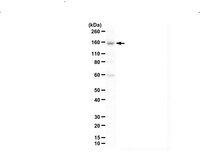ABE1865 Sigma-AldrichAnti-UTX (KDM6A)
Anti-UTX (KDM6A), Cat. No. ABE1865, is a highly specific rabbit polyclonal antibody that targets Lysine-specific demethylase 6A and has been tested in Chromatin Immunoprecipitation (ChIP), Immunocytochemistry, Immunofluorescence, Immunoprecipitation, and Western blotting.
More>> Anti-UTX (KDM6A), Cat. No. ABE1865, is a highly specific rabbit polyclonal antibody that targets Lysine-specific demethylase 6A and has been tested in Chromatin Immunoprecipitation (ChIP), Immunocytochemistry, Immunofluorescence, Immunoprecipitation, and Western blotting. Less<<Recommended Products
Overview
| Replacement Information |
|---|
Key Spec Table
| Species Reactivity | Key Applications | Host | Format | Antibody Type |
|---|---|---|---|---|
| H, M | ChIP, ICC, IF, IP, WB | Rb | Affinity Purified | Polyclonal Antibody |
| References |
|---|
| Product Information | |
|---|---|
| Format | Affinity Purified |
| Presentation | Purified rabbit polyclonal antibody in buffer containing 0.1 M Tris-Glycine (pH 7.4), 150 mM NaCl with 0.05% sodium azide. |
| Quality Level | MQ100 |
| Physicochemical Information |
|---|
| Dimensions |
|---|
| Materials Information |
|---|
| Toxicological Information |
|---|
| Safety Information according to GHS |
|---|
| Safety Information |
|---|
| Storage and Shipping Information | |
|---|---|
| Storage Conditions | Stable for 1 year at 2-8°C from date of receipt. |
| Packaging Information | |
|---|---|
| Material Size | 100 μg |
| Transport Information |
|---|
| Supplemental Information |
|---|
| Specifications |
|---|
| Global Trade Item Number | |
|---|---|
| Catalogue Number | GTIN |
| ABE1865 | 04054839132988 |
Documentation
Anti-UTX (KDM6A) SDS
| Title |
|---|
Anti-UTX (KDM6A) Certificates of Analysis
| Title | Lot Number |
|---|---|
| Anti-UTX (KDM6A) - 3322985 | 3322985 |
| Anti-UTX (KDM6A) - 3537564 | 3537564 |
| Anti-UTX (KDM6A) - 3736623 | 3736623 |
| Anti-UTX (KDM6A) - 3925315 | 3925315 |
| Anti-UTX (KDM6A) - 4027365 | 4027365 |
| Anti-UTX (KDM6A) -Q2795448 | Q2795448 |














